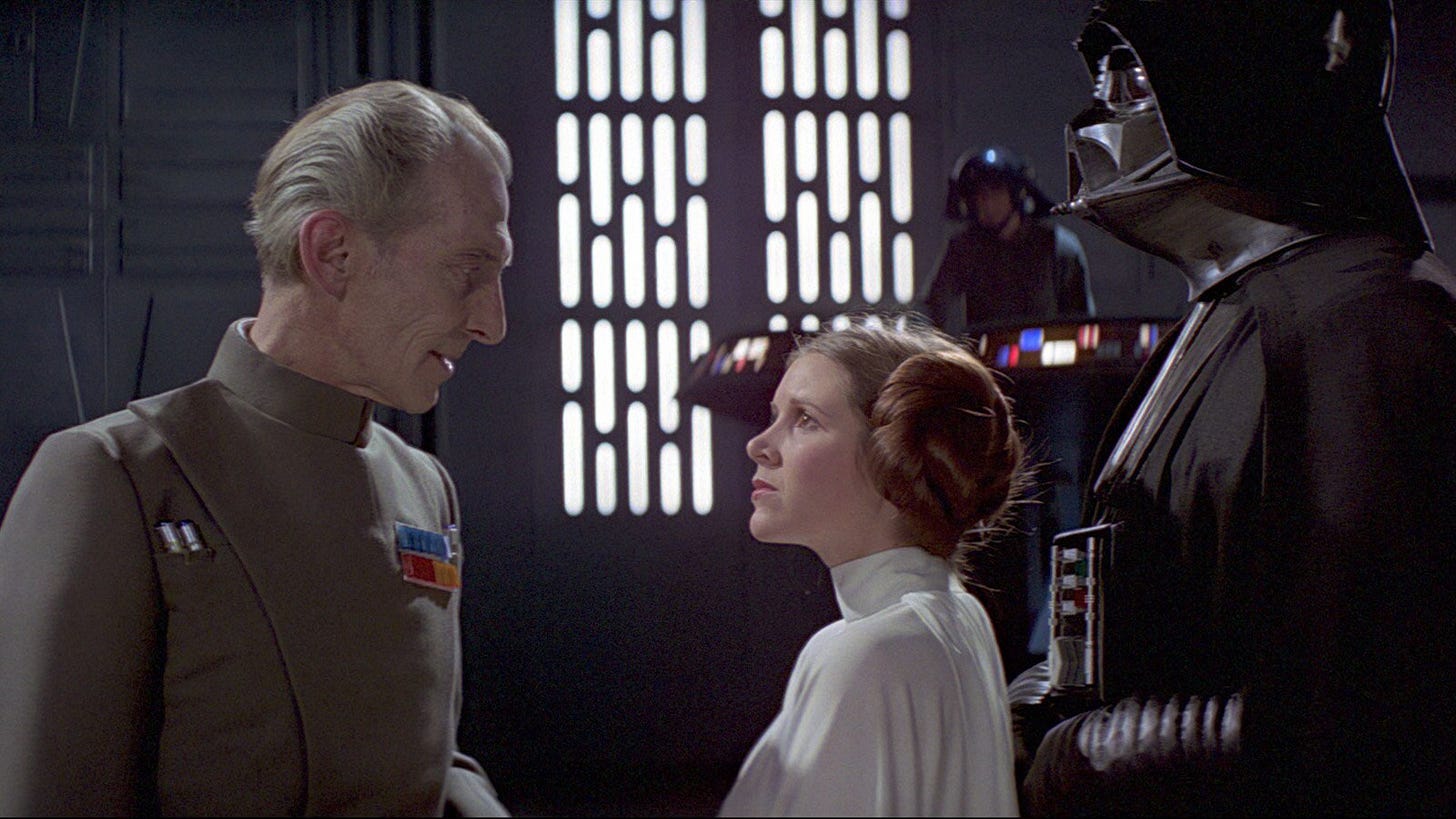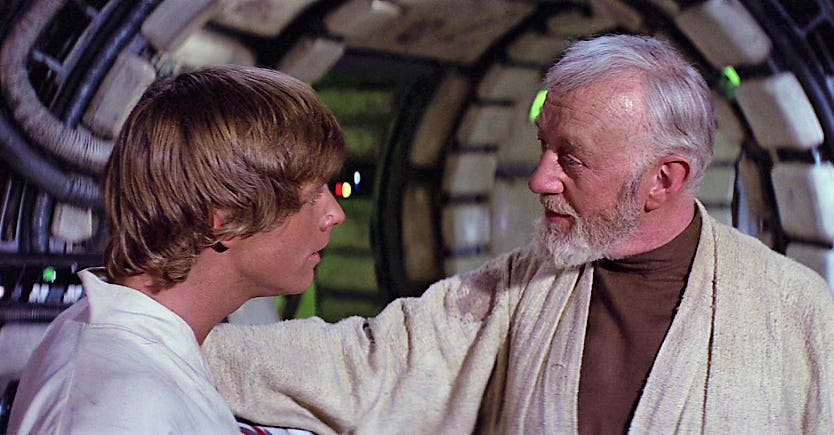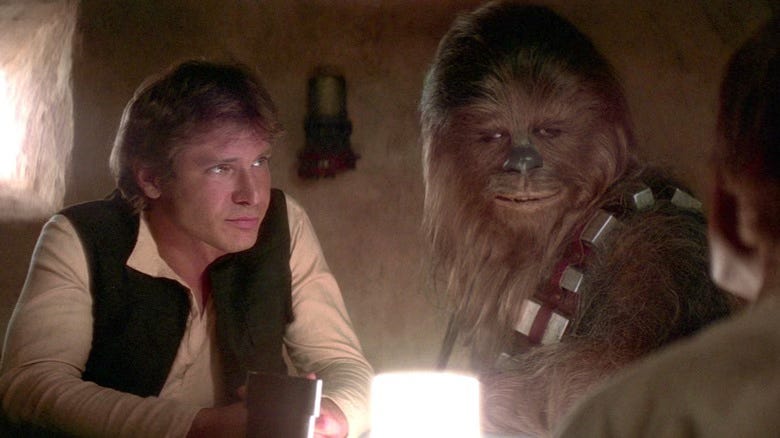>>”The more you tighten your grip, Tarkin, the more star systems will slip through your fingers.” — Princess Leia Organa
Disclaimer: We do not come into this world loaded with pop culture knowledge. Be warned that I will be spoiling the Star Wars franchise. So, if you care to not be spoiled … look away.
My family and I just rewatched the original Star Wars trilogy — on DVDs purchased because my sons and I had never seen the “original” theatrical releases. That word — original — must already be in quotation marks, because apparently from the moment the first movie, Star Wars, was released, George Lucas couldn’t keep himself from tinkering with it.
(This first movie was later retitled A New Hope, then rebranded as Episode IV: A New Hope, and eventually referred to with the full extended title — all layered on retroactively.)
The original cinematic release of 1977’s A New Hope was recently shown at the British Film Institute (BFI)'s Film on Film festival back in June. This is special because even the “original” release edition of the film isn’t the one boasted as such on the DVD, though it’s close and doesn’t include all the questionable changes made in the 1990’s re-releases. In fact, Lucas started tweaking things even during the film’s original 1977 run — adding or adjusting sound effects and other details almost immediately.
One might say, he tampers. He cannot seem to stop from fiddling with his product — leaving it constantly in a state of unfinishedness for decades that many fans and critics thought made it worse for the wear. Having now finally seen this original-ish film and its two sequels, The Empire Strikes Back (1980) and The Return of the Jedi (1983) — and, maybe this is pretty important too, not having watched them in preparation of another movie in the franchise being released — I can really see the charm and uniqueness of this epic space opera in ways I couldn’t before.
I was born between the first (IV) and second (V) movies, and I didn’t even see them until I was around 18 or 19 years old. But I never knew any other outcome than that Darth Vader is Luke’s father et al., and have no concept of reveals or surprises in this original trilogy.
Additionally, I am vaguely aware of the book, Splinter of the Mind’s Eye. Published in 1978, this book was written as a low-budget Star Wars sequel, and is the first original storyline that breaks open what would become the Star Wars Expanded Universe — the whole of which, not just this early book, is now no longer considered canon. The novel follows Luke and Leia on Mimban, where they face the Empire and Darth Vader.
I say “vaguely aware” in the sense that we own the book and my younger son and husband have both read it. I have no interest in reading it.
However, the idea of this book combined with re-watching the original trilogy (with the original songs, the original backdrops, and Han shooting first, dammit, and without many other tweaks and CGI noodling), made me really wish there was some version of this story that stuck absolutely with what was laid out in Star Wars: Episode IV – A New Hope.
Would it still have the same cultural impact? Maybe — even probably — because it was the first of its kind and audiences had no expectations going in. And imagine a Star Wars world where no retcons (retroactive continuity changes) were introduced to twist the narrative, conflicting with or weakening the simplicity and clarity of A New Hope's setup.
Let’s discuss.
1. Darth Vader is not Luke’s father
In A New Hope: Obi-Wan tells Luke that Darth Vader betrayed and murdered Luke's father, Anakin Skywalker.
Later retcon (The Empire Strikes Back): Vader is Anakin Skywalker.
Implication: This is a major retcon and a huge reveal — and yes, a significant cultural impact. But, we’re playing pretend, so rein in any ire. In A New Hope, the intent is that Anakin is dead, and Vader is a separate character.
Impact: This twist is absolutely compelling, but it introduces contradictions that later films (especially Return of the Jedi) must awkwardly explain — e.g., Obi-Wan’s “certain point of view” speech. The original phrasing is clearly metaphorical but only in hindsight.
2. Leia is not Luke’s sister
In A New Hope: There is romantic tension between Luke and Leia; Han is the rival. No hints of siblinghood.
Later retcon (Return of the Jedi): Leia is revealed to be Luke’s twin sister, hidden at birth.
Implication: This was clearly not planned in A New Hope — the dialogue, body language, and plot structure support a love triangle, not a family reunion.
Impact: This forces some mental gymnastics to avoid the discomfort in retrospect (e.g., the kiss in Empire Strikes Back) and forces awkward dialogue later to retroactively fit it all together.
One of my favorite memes about this says something like:Obi-Wan: You have a sister.
Luke: I know one woman.
Obi-Wan: Yep, that’s her.
3. Obi-Wan was not necessarily Anakin's master
In A New Hope: Obi-Wan says he knew Luke's father and that they fought together in the Clone Wars.
Later clarification (prequels, mainly The Phantom Menace, 1999): Obi-Wan trained Anakin as his Padawan.
Implication: In A New Hope, the Jedi seem more like special forces (heh-heh) or wandering knights. There’s no strong sense of a strict master-apprentice hierarchy — though there are hints.
Impact: Later films cement a formal, bureaucratic Jedi Order, which doesn’t contradict A New Hope outright, but certainly wasn’t present in the original storytelling. That said, Vader’s line — “When I left you, I was but the learner; now I am the master” — does suggest some kind of past relationship. But it doesn’t necessarily point to a formal Jedi apprenticeship, and it definitely doesn’t reveal that Vader was once Anakin Skywalker.
Side note: Wouldn’t that have been an interesting idea to explore in the prequels? Obi-Wan teaching a young Vader? (As in: “a young Jedi named Darth Vader, who was a pupil of mine…”
4. The nature of the Force and Jedi is vague and mystical
In A New Hope: The Force is a mysterious energy field. It’s spiritual, intuitive, and vague. Jedi are extinct knights, more mythical than institutional.
Later developments (especially in the prequels): The Force becomes partly biological (hello, midichlorians), and the Jedi turn into a full-blown bureaucracy with military ranks.
Impact: These changes arguably demystify the Force and reduce the mythic feel of A New Hope.
Side note: I love the goofiness of the line when Luke admonishes Han for not believing in the Force. Like, dude…YOU just found out about it yesterday. Calm down, son.
5. Anakin Skywalker wasn’t conceived as the “Chosen One” yet
In A New Hope: Anakin is a heroic Jedi who was killed by Vader. No grand prophecy or immaculate conception.
Later retcon (prequels): Anakin is the prophesied Chosen One, born of a virgin mother through the Force.
Impact: These mythological elements were added much later, and don’t mesh naturally with the grounded war-story tone of the original film.
6. The Emperor is barely mentioned
In A New Hope: The Emperor is referred to once in passing by Tarkin, as having "dissolved the Senate."
Later films (Empire and Jedi): The Emperor becomes the central villain, a Sith Master who directly controls Vader.
Impact: The absence of Palpatine in A New Hope suggests his later importance was not yet fleshed out.
7. Yoda is not mentioned
In A New Hope: Obi-Wan says he was trained by "Master Yoda" in Empire Strikes Back.
Retcon or omission?: Not necessarily a contradiction, but it underscores how underdeveloped the Jedi past still was in A New Hope.
Impact: How might it change the prequels if Obi-Wan had been trained by Yoda, leaving Qui-Gon Jinn, who is all the feels and is not a rule-follower, to train Anakin.
Looking at A New Hope on its own, before all the later twists and retcons, the Star Wars galaxy feels a lot bigger, wilder, and more open. If Vader isn’t Luke’s father and Leia isn’t his sister, then scenes like Vader interrogating Leia make perfect sense — he’s just the villain, and she’s a captured rebel leader. There’s no weird “How did he not know?” moment because there’s no hidden family connection. Same with him bumping into R2D2.
The characters don’t all have to be related for the story to matter. That actually makes the galaxy feel larger, full of different people whose lives cross paths through war and chance, not fate. Like with R2-D2 and C-3PO — later movies tie them directly to Anakin, which is a bit much. They worked much better as droids just caught up in the chaos, not heirlooms from the abandoned Skywalker attic.
Even Yoda, who doesn’t show up at all in A New Hope, was later folded into everything in the prequels — turning him from a mysterious old Jedi (who is an absolutely charming, sometimes cross-eyed, puppet in the original trilogy) into a high-ranking Jedi who helped shape — and overlook — the downfall of the Republic. And while all these connections might make things more dramatic, they also make the universe feel smaller, like everything somehow comes back to the same handful of people. It’s a tighter story, sure, but it loses some of that original sense of scale and wonder.
Maybe that’s the lesson here: sometimes it’s okay to leave things open, to let mystery and magic fill the gaps. In the original Star Wars, despite its charmingly apparent low budget, it really did feel like a story that might have happened a long time ago in a galaxy far, far away — where princesses were secretly rebels, rebels fought empires, droids stumbled into adventure, and not every character had to be someone’s long-lost relative or hidden offspring. A New Hope had gaps, sure, but those gaps gave the galaxy room to breathe. At the end of that first film, you can feel it wanting to stretch and expand. But as the saga continued — in all directions from that one beginning — the universe seemed to contract, folding in on itself until every plotline traced back to one family, one prophecy, one fate. There’s still magic to be found in it. But sometimes I wish Lucas had stopped kneading the dough before all the air was gone. It rose just fine the first time.
Though, I will say, clearly Lucas was right about the Trade Wars.
Happy kneading,
—C.





